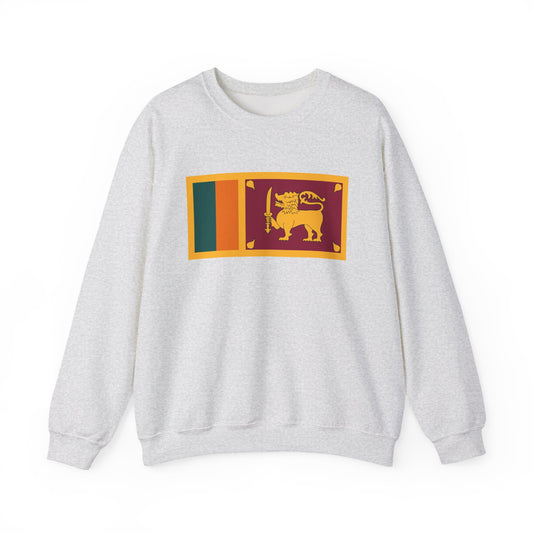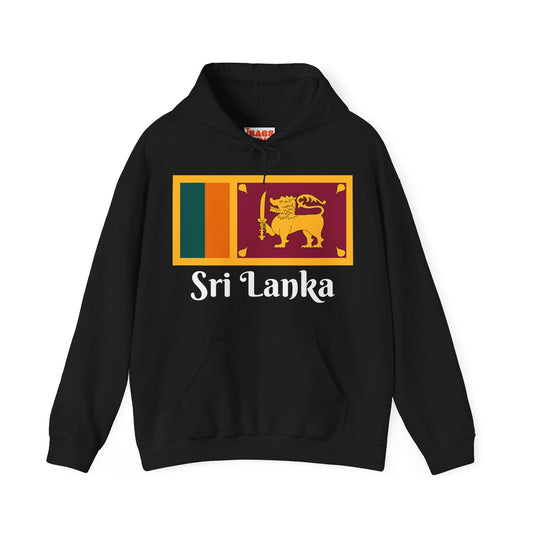-
Sri Lanka Flag Sweatshirt
Regular price $34.15 USDRegular priceUnit price / per -
Sri Lanka Sweatshirt
Regular price $34.15 USDRegular priceUnit price / per -
Sri Lanka Leather Patch Hat
Regular price $18.85 USDRegular priceUnit price / per -
Sri Lanka Mug
Regular price $11.65 USDRegular priceUnit price / per -
Sri Lanka Trucker Cap
Regular price $14.90 USDRegular priceUnit price / per -
Sri Lanka Hoodies
Regular price $34.40 USDRegular priceUnit price / per -
Sri Lanka T-shirts
Regular price $22.79 USDRegular priceUnit price / per -
Sri Lanka Flag Hoodies
Regular price $34.40 USDRegular priceUnit price / per -
Sri Lanka Flag on T-shirt
Regular price $22.79 USDRegular priceUnit price / per
Collection: Sri Lanka
The Sri Lanka flag is a symbol of national pride and identity for Sri Lankans. With its unique design and colors, the flag represents this beautiful island nation's rich history and culture. We will explore the journey of the Sri Lanka flag from its adoption to the present day, covering its design, historical context, symbolism, current relevance, and additional facts.
Overview of the Sri Lanka Flag

The flag of Sri Lanka showcases a distinctive and vibrant composition, featuring a rich maroon background emblazoned with a golden lion brandishing a sword in its right forepaw, a symbol of strength and bravery. Flanking the lion are four bo leaves in each corner, signifying the four Buddhist virtues. The background is bordered on two sides by vertical stripes of green and saffron orange, each color reflecting the island's diverse cultural fabric - the green stripe represents the country’s Muslim community. In contrast, the saffron stripe stands for the Hindu Tamil population.
This harmonious blend of symbols and colors encapsulates the essence of Sri Lanka’s heritage, embodying unity, morality, and the nation’s rich multicultural identity. The flag's unique design elements, from the fearless lion to the sacred bo leaves, weave together a narrative of peace, courage, and national pride that resonates deeply with the Sri Lankan people.
Historical Context of the Sri Lanka Flag
The origins of the flag of Sri Lanka can be traced back to a time when the island was known by a different name and ruled by ancient monarchs. The lion symbol, a central figure in the flag's design, is deeply rooted in the nation's history, symbolizing the Sinhalese people, and has been a hallmark of Sri Lankan flags for centuries. Adopting the current flag design on May 22, 1972, marked a significant chapter in Sri Lanka's journey as it transitioned to a republic, shedding colonial influences and embracing a new era of sovereignty.
This event culminated in various historical influences and alterations that the flag underwent, reflecting the country’s evolving political landscape. Throughout its history, the flag has served as a powerful emblem of the island’s sovereignty, resilience, and the unity of its diverse communities. Its evolution from ancient symbols to its current form is a testament to Sri Lanka's rich tapestry of history, embodying the nation's aspirations and the diverse heritage of its people.
Symbolism Behind the Sri Lanka Flag

The intricate design and vibrant colors of the Sri Lanka flag are imbued with profound symbolic meanings that reflect the country’s heritage and the principles of its people. Central to the flag is the golden lion, which stands as a powerful emblem of bravery and strength, signifying the courage of the Sinhalese people. The lion holds a sword, symbolizing the nation's sovereignty and the government's commitment to justice and authority. Surrounding the lion are the four bo leaves, placed at each corner of the maroon background. These leaves are not mere decorative elements; they are deeply symbolic of the four cardinal virtues of Buddhism - loving kindness, compassion, sympathetic joy, and equanimity. These principles guide the nation's moral compass and are integral to the Sri Lankan way of life.
The flag also celebrates the island's multicultural identity through its use of color. Beyond serving as a backdrop for the lion and leaves, the maroon background represents the majority Buddhist community. The vertical stripes of green and saffron orange on the flag's border highlight the island’s diversity, with green standing for the Muslim faith and orange for the Hindu Tamil population. This inclusion of all major communities underscores the ideals of unity and peace amidst diversity, a core value that Sri Lanka continues to uphold. Through its symbols and colors, the flag of Sri Lanka narrates the story of a nation built on the foundations of courage, compassion, and communal harmony.
Current Relevance of the Sri Lanka Flag
In contemporary Sri Lanka, the flag remains a potent symbol of national identity, prominently featured in a wide array of settings from governmental buildings to sporting events, and is a focal point during Independence Day celebrations. Its presence reinforces the country's unity and shared values, especially in times of national triumph or tragedy, serving as a rallying point for the populace. Despite its unifying intent, the flag has also been at the center of debates, particularly in contexts where ethnic and political tensions surface.
These discussions often reflect the broader challenges of ensuring that all communities within Sri Lanka feel represented and included under a single national identity. The flag's symbolism and ideals, including unity and diversity, play a crucial role in ongoing efforts towards reconciliation and peace-building in a post-conflict era. Its role in military ceremonies underscores the commitment to defend the nation's sovereignty and the principles encapsulated in the flag's design. Through these various dimensions, the Sri Lanka flag continues to be a significant part of the nation's fabric, embodying both its aspirations and complexities.
Additional Facts About the Sri Lanka Flag
Handling and displaying the flag of Sri Lanka comes with a set of rules aimed at preserving its dignity and significance. For instance, it is imperative that the flag is never allowed to touch the ground, symbolizing respect and honor for the nation. Additionally, displaying the flag in a manner deemed disrespectful, such as flying it upside down, is strictly prohibited. These guidelines ensure the flag is always represented in a manner befitting its status as a national symbol. Interestingly, the inspiration for the current design of the flag has its roots in the Lion Flag, revered by the ancient rulers of the island, indicating a deep historical lineage that adds to its significance. Furthermore, the Sri Lanka flag is recognized as one of the oldest flags with a documented history, highlighting the enduring nature of its symbols and the long-standing cultural heritage they represent. This historical depth and the established protocols for its display emphasize the flag's pivotal role in representing the sovereignty and pride of Sri Lanka on both a national and international stage.


















